Francesco Mosca, il Moschino began his career working under his father, Simone Mosca, on the Duomo of Orvieto. According to Giorgio Vasari, when Simone Mosca died in 1553, “Francesco Moschino was ... elected to his father's place by the Opera del Duomo, but, thinking nothing of it, he left it to Raffaello da Montelupo, and went to Rome”. In fact, he stayed in Orvieto until December 1556.
He spent most of the rest of his career in the service of Duke Cosimo I de' Medici of Florence. His most important works from this part of his career were in the Duomo of Pisa.
Duomo, Orvieto
Francesco Mosca, who started work at the Duomo under his father, was subsequently centrally involved in its 16th century remodelling until his departure from Orvieto in December 1556.
Cappella dei Magi (ca. 1545-6)
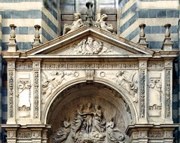
According to Giorgio Vasari: “a son of [Simone Mosca] called Francesco, and as a bye-name il Moschino, a boy 15 years of age .... executed ... under the discipline of his father ... [the following work on the Cappella dei Magi]: the angels that are holding the inscriptions between the pilasters; then the God the Father in the pediment; as well as the angels that are in the lunette of that work, ... ; and finally the Victories at the sides of the lunette; by which works he caused everyone to wonder and marvel”.
Simone Mosca had taken over the work on this chapel in the right transept, and Raffaello da Montelupo had executed the lower part of the central relief in the period to 1541. The young Francesco Mosca probably completed the chapel in 1545-6.
Cappella della Visitazione (1547-54)
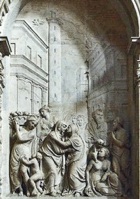
In the central relief, the meeting between the Virgin and St Elizabeth prior to the birth of their respective sons is set among buildings that are sketched in deep perspective. Francesco Mosca must have been very proud of this work, because he suggested that the Opera del Duomo should take advice from Michelangelo as to it value. In the event, this suggestion does not seem to have been taken up.
Prophets (1555-6)
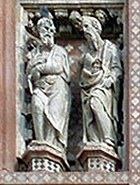
St Paul (1556)
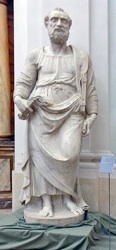
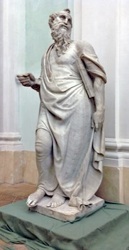
St Peter (1560) by St Paul (1556) by
Raffaello da Montelupo Francesco Mosca, il Moschino
Giorgio Vasari recorded that: “Work being then continued on the execution of the Apostles for the church, [Francesco Mosca, il Moschino] made a St Peter and a St Paul of the same size, which were held to be creditable statues”. Documents relating to this commission began in 1554, when the Opera del Duomo sent Francesco Mosca to Carrara to obtain marble for four planned sculptures:
-
✴these over life-sized statues of SS Peter and Paul;
-
✴a figure of St Sebastian (see below);
-
✴and a group of the Pietà.
The choice of the three saints was probably intended to underline the strong links between Orvieto and papal Rome.
In fact, the marble did not reach Orvieto until 1556, and Francesco Mosca had completed only the figure of St Paul before he left Orvieto later that year. The figure was subsequently placed by the first column on the right. Raffaello da Montelupo executed the figure of St Peter in 1560, and this was placed as a pendant to St Paul (i.e. by the first column on the left). These did indeed become the first of a series of figures of the Apostles in the nave. All of these figures are now exhibited in the ex-church of Sant’ Agostino.
St Sebastian (1556-7)
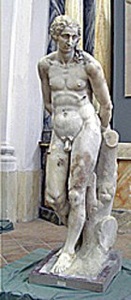
This was the third figure for which Francesco Mosca had selected marble in 1554 (see above), and it was unfinished when he left Orvieto in 1556. Ippolito Scalza finished it, and it was then placed in the new niche to the left the entrance to the Cappella Nuova. It was moved to the counter-facade, probably in ca. 1593, where it formed a pendant to a figure (1593) by Fabiano Toti of St Roch, another plague saint. Both are now exhibited in the ex-church of Sant’ Agostino.
Read more:
F. Piagnani and L. Principi, “La Scultura del Cinquecento in Orvieto”, in
C. Benocci et al. (Eds), “Storia di Orvieto: Quattrocento e Cinquecento” (2010) Pisa, Volume II, pp 585-636
Return to Art in: Orvieto.
Return to “Foreign” Sculptors in Umbria.



